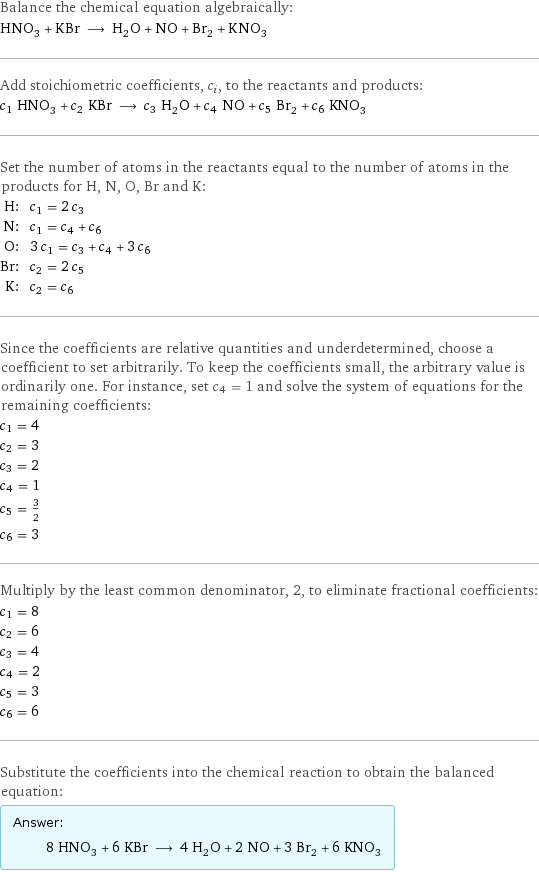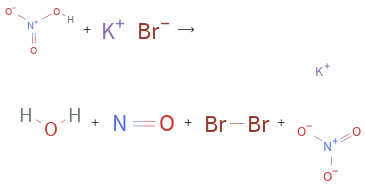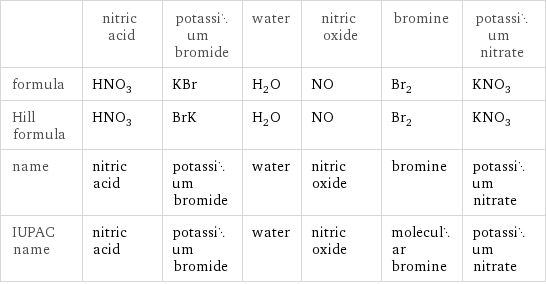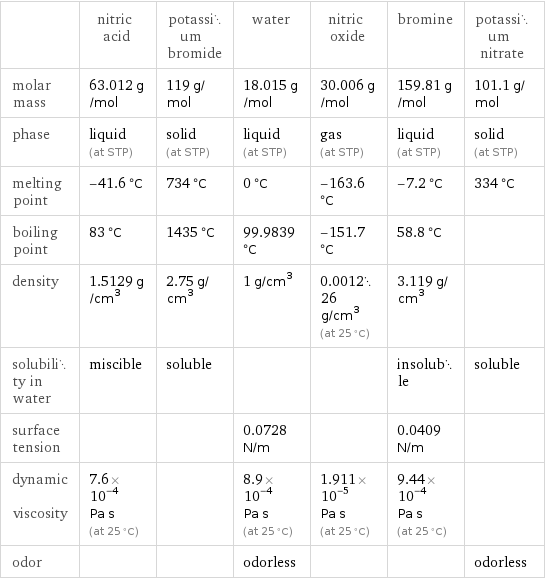Input interpretation

HNO_3 nitric acid + KBr potassium bromide ⟶ H_2O water + NO nitric oxide + Br_2 bromine + KNO_3 potassium nitrate
Balanced equation

Balance the chemical equation algebraically: HNO_3 + KBr ⟶ H_2O + NO + Br_2 + KNO_3 Add stoichiometric coefficients, c_i, to the reactants and products: c_1 HNO_3 + c_2 KBr ⟶ c_3 H_2O + c_4 NO + c_5 Br_2 + c_6 KNO_3 Set the number of atoms in the reactants equal to the number of atoms in the products for H, N, O, Br and K: H: | c_1 = 2 c_3 N: | c_1 = c_4 + c_6 O: | 3 c_1 = c_3 + c_4 + 3 c_6 Br: | c_2 = 2 c_5 K: | c_2 = c_6 Since the coefficients are relative quantities and underdetermined, choose a coefficient to set arbitrarily. To keep the coefficients small, the arbitrary value is ordinarily one. For instance, set c_4 = 1 and solve the system of equations for the remaining coefficients: c_1 = 4 c_2 = 3 c_3 = 2 c_4 = 1 c_5 = 3/2 c_6 = 3 Multiply by the least common denominator, 2, to eliminate fractional coefficients: c_1 = 8 c_2 = 6 c_3 = 4 c_4 = 2 c_5 = 3 c_6 = 6 Substitute the coefficients into the chemical reaction to obtain the balanced equation: Answer: | | 8 HNO_3 + 6 KBr ⟶ 4 H_2O + 2 NO + 3 Br_2 + 6 KNO_3
Structures

+ ⟶ + + +
Names

nitric acid + potassium bromide ⟶ water + nitric oxide + bromine + potassium nitrate
Reaction thermodynamics
Gibbs free energy

| nitric acid | potassium bromide | water | nitric oxide | bromine | potassium nitrate molecular free energy | -80.7 kJ/mol | -380.7 kJ/mol | -237.1 kJ/mol | 87.6 kJ/mol | 0 kJ/mol | -394.9 kJ/mol total free energy | -645.6 kJ/mol | -2284 kJ/mol | -948.4 kJ/mol | 175.2 kJ/mol | 0 kJ/mol | -2369 kJ/mol | G_initial = -2930 kJ/mol | | G_final = -3143 kJ/mol | | | ΔG_rxn^0 | -3143 kJ/mol - -2930 kJ/mol = -212.8 kJ/mol (exergonic) | | | | |
Equilibrium constant
![Construct the equilibrium constant, K, expression for: HNO_3 + KBr ⟶ H_2O + NO + Br_2 + KNO_3 Plan: • Balance the chemical equation. • Determine the stoichiometric numbers. • Assemble the activity expression for each chemical species. • Use the activity expressions to build the equilibrium constant expression. Write the balanced chemical equation: 8 HNO_3 + 6 KBr ⟶ 4 H_2O + 2 NO + 3 Br_2 + 6 KNO_3 Assign stoichiometric numbers, ν_i, using the stoichiometric coefficients, c_i, from the balanced chemical equation in the following manner: ν_i = -c_i for reactants and ν_i = c_i for products: chemical species | c_i | ν_i HNO_3 | 8 | -8 KBr | 6 | -6 H_2O | 4 | 4 NO | 2 | 2 Br_2 | 3 | 3 KNO_3 | 6 | 6 Assemble the activity expressions accounting for the state of matter and ν_i: chemical species | c_i | ν_i | activity expression HNO_3 | 8 | -8 | ([HNO3])^(-8) KBr | 6 | -6 | ([KBr])^(-6) H_2O | 4 | 4 | ([H2O])^4 NO | 2 | 2 | ([NO])^2 Br_2 | 3 | 3 | ([Br2])^3 KNO_3 | 6 | 6 | ([KNO3])^6 The equilibrium constant symbol in the concentration basis is: K_c Mulitply the activity expressions to arrive at the K_c expression: Answer: | | K_c = ([HNO3])^(-8) ([KBr])^(-6) ([H2O])^4 ([NO])^2 ([Br2])^3 ([KNO3])^6 = (([H2O])^4 ([NO])^2 ([Br2])^3 ([KNO3])^6)/(([HNO3])^8 ([KBr])^6)](../image_source/9ee8db39b5eddd6f9c5c01b88ba1693c.png)
Construct the equilibrium constant, K, expression for: HNO_3 + KBr ⟶ H_2O + NO + Br_2 + KNO_3 Plan: • Balance the chemical equation. • Determine the stoichiometric numbers. • Assemble the activity expression for each chemical species. • Use the activity expressions to build the equilibrium constant expression. Write the balanced chemical equation: 8 HNO_3 + 6 KBr ⟶ 4 H_2O + 2 NO + 3 Br_2 + 6 KNO_3 Assign stoichiometric numbers, ν_i, using the stoichiometric coefficients, c_i, from the balanced chemical equation in the following manner: ν_i = -c_i for reactants and ν_i = c_i for products: chemical species | c_i | ν_i HNO_3 | 8 | -8 KBr | 6 | -6 H_2O | 4 | 4 NO | 2 | 2 Br_2 | 3 | 3 KNO_3 | 6 | 6 Assemble the activity expressions accounting for the state of matter and ν_i: chemical species | c_i | ν_i | activity expression HNO_3 | 8 | -8 | ([HNO3])^(-8) KBr | 6 | -6 | ([KBr])^(-6) H_2O | 4 | 4 | ([H2O])^4 NO | 2 | 2 | ([NO])^2 Br_2 | 3 | 3 | ([Br2])^3 KNO_3 | 6 | 6 | ([KNO3])^6 The equilibrium constant symbol in the concentration basis is: K_c Mulitply the activity expressions to arrive at the K_c expression: Answer: | | K_c = ([HNO3])^(-8) ([KBr])^(-6) ([H2O])^4 ([NO])^2 ([Br2])^3 ([KNO3])^6 = (([H2O])^4 ([NO])^2 ([Br2])^3 ([KNO3])^6)/(([HNO3])^8 ([KBr])^6)
Rate of reaction
![Construct the rate of reaction expression for: HNO_3 + KBr ⟶ H_2O + NO + Br_2 + KNO_3 Plan: • Balance the chemical equation. • Determine the stoichiometric numbers. • Assemble the rate term for each chemical species. • Write the rate of reaction expression. Write the balanced chemical equation: 8 HNO_3 + 6 KBr ⟶ 4 H_2O + 2 NO + 3 Br_2 + 6 KNO_3 Assign stoichiometric numbers, ν_i, using the stoichiometric coefficients, c_i, from the balanced chemical equation in the following manner: ν_i = -c_i for reactants and ν_i = c_i for products: chemical species | c_i | ν_i HNO_3 | 8 | -8 KBr | 6 | -6 H_2O | 4 | 4 NO | 2 | 2 Br_2 | 3 | 3 KNO_3 | 6 | 6 The rate term for each chemical species, B_i, is 1/ν_i(Δ[B_i])/(Δt) where [B_i] is the amount concentration and t is time: chemical species | c_i | ν_i | rate term HNO_3 | 8 | -8 | -1/8 (Δ[HNO3])/(Δt) KBr | 6 | -6 | -1/6 (Δ[KBr])/(Δt) H_2O | 4 | 4 | 1/4 (Δ[H2O])/(Δt) NO | 2 | 2 | 1/2 (Δ[NO])/(Δt) Br_2 | 3 | 3 | 1/3 (Δ[Br2])/(Δt) KNO_3 | 6 | 6 | 1/6 (Δ[KNO3])/(Δt) (for infinitesimal rate of change, replace Δ with d) Set the rate terms equal to each other to arrive at the rate expression: Answer: | | rate = -1/8 (Δ[HNO3])/(Δt) = -1/6 (Δ[KBr])/(Δt) = 1/4 (Δ[H2O])/(Δt) = 1/2 (Δ[NO])/(Δt) = 1/3 (Δ[Br2])/(Δt) = 1/6 (Δ[KNO3])/(Δt) (assuming constant volume and no accumulation of intermediates or side products)](../image_source/1a9202d90ad8cceb6db1eda96f9297b0.png)
Construct the rate of reaction expression for: HNO_3 + KBr ⟶ H_2O + NO + Br_2 + KNO_3 Plan: • Balance the chemical equation. • Determine the stoichiometric numbers. • Assemble the rate term for each chemical species. • Write the rate of reaction expression. Write the balanced chemical equation: 8 HNO_3 + 6 KBr ⟶ 4 H_2O + 2 NO + 3 Br_2 + 6 KNO_3 Assign stoichiometric numbers, ν_i, using the stoichiometric coefficients, c_i, from the balanced chemical equation in the following manner: ν_i = -c_i for reactants and ν_i = c_i for products: chemical species | c_i | ν_i HNO_3 | 8 | -8 KBr | 6 | -6 H_2O | 4 | 4 NO | 2 | 2 Br_2 | 3 | 3 KNO_3 | 6 | 6 The rate term for each chemical species, B_i, is 1/ν_i(Δ[B_i])/(Δt) where [B_i] is the amount concentration and t is time: chemical species | c_i | ν_i | rate term HNO_3 | 8 | -8 | -1/8 (Δ[HNO3])/(Δt) KBr | 6 | -6 | -1/6 (Δ[KBr])/(Δt) H_2O | 4 | 4 | 1/4 (Δ[H2O])/(Δt) NO | 2 | 2 | 1/2 (Δ[NO])/(Δt) Br_2 | 3 | 3 | 1/3 (Δ[Br2])/(Δt) KNO_3 | 6 | 6 | 1/6 (Δ[KNO3])/(Δt) (for infinitesimal rate of change, replace Δ with d) Set the rate terms equal to each other to arrive at the rate expression: Answer: | | rate = -1/8 (Δ[HNO3])/(Δt) = -1/6 (Δ[KBr])/(Δt) = 1/4 (Δ[H2O])/(Δt) = 1/2 (Δ[NO])/(Δt) = 1/3 (Δ[Br2])/(Δt) = 1/6 (Δ[KNO3])/(Δt) (assuming constant volume and no accumulation of intermediates or side products)
Chemical names and formulas

| nitric acid | potassium bromide | water | nitric oxide | bromine | potassium nitrate formula | HNO_3 | KBr | H_2O | NO | Br_2 | KNO_3 Hill formula | HNO_3 | BrK | H_2O | NO | Br_2 | KNO_3 name | nitric acid | potassium bromide | water | nitric oxide | bromine | potassium nitrate IUPAC name | nitric acid | potassium bromide | water | nitric oxide | molecular bromine | potassium nitrate
Substance properties

| nitric acid | potassium bromide | water | nitric oxide | bromine | potassium nitrate molar mass | 63.012 g/mol | 119 g/mol | 18.015 g/mol | 30.006 g/mol | 159.81 g/mol | 101.1 g/mol phase | liquid (at STP) | solid (at STP) | liquid (at STP) | gas (at STP) | liquid (at STP) | solid (at STP) melting point | -41.6 °C | 734 °C | 0 °C | -163.6 °C | -7.2 °C | 334 °C boiling point | 83 °C | 1435 °C | 99.9839 °C | -151.7 °C | 58.8 °C | density | 1.5129 g/cm^3 | 2.75 g/cm^3 | 1 g/cm^3 | 0.001226 g/cm^3 (at 25 °C) | 3.119 g/cm^3 | solubility in water | miscible | soluble | | | insoluble | soluble surface tension | | | 0.0728 N/m | | 0.0409 N/m | dynamic viscosity | 7.6×10^-4 Pa s (at 25 °C) | | 8.9×10^-4 Pa s (at 25 °C) | 1.911×10^-5 Pa s (at 25 °C) | 9.44×10^-4 Pa s (at 25 °C) | odor | | | odorless | | | odorless
Units
